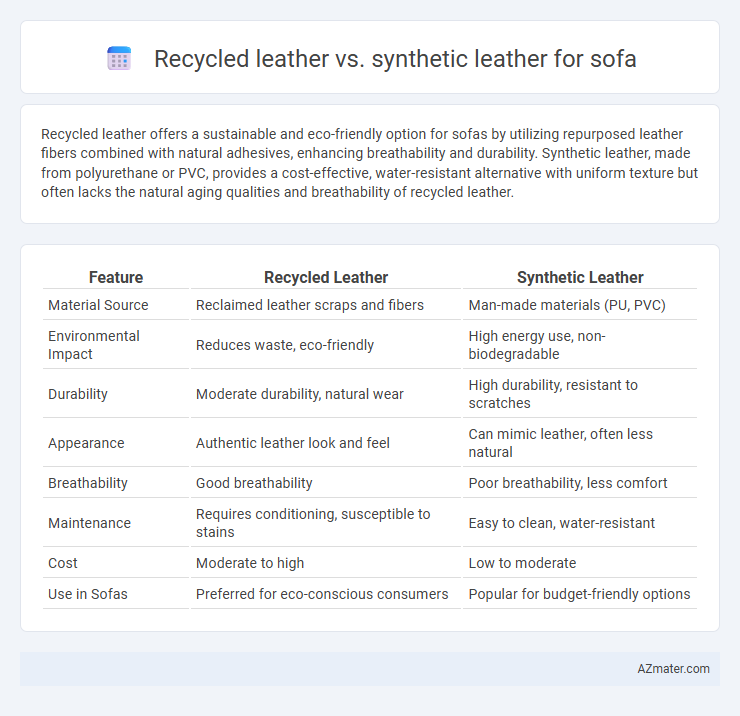Recycled leather offers a sustainable and eco-friendly option for sofas by utilizing repurposed leather fibers combined with natural adhesives, enhancing breathability and durability. Synthetic leather, made from polyurethane or PVC, provides a cost-effective, water-resistant alternative with uniform texture but often lacks the natural aging qualities and breathability of recycled leather.
Table of Comparison
| Feature | Recycled Leather | Synthetic Leather |
|---|---|---|
| Material Source | Reclaimed leather scraps and fibers | Man-made materials (PU, PVC) |
| Environmental Impact | Reduces waste, eco-friendly | High energy use, non-biodegradable |
| Durability | Moderate durability, natural wear | High durability, resistant to scratches |
| Appearance | Authentic leather look and feel | Can mimic leather, often less natural |
| Breathability | Good breathability | Poor breathability, less comfort |
| Maintenance | Requires conditioning, susceptible to stains | Easy to clean, water-resistant |
| Cost | Moderate to high | Low to moderate |
| Use in Sofas | Preferred for eco-conscious consumers | Popular for budget-friendly options |
Introduction: Understanding Recycled Leather and Synthetic Leather
Recycled leather is crafted from shredded genuine leather scraps combined with polyurethane, offering an eco-friendly alternative with natural texture and durability. Synthetic leather, often made from polyurethane or polyvinyl chloride (PVC), provides a cost-effective, water-resistant option with consistent color and grain. Both materials are popular choices for sofas, balancing sustainability, appearance, and maintenance requirements.
Composition and Manufacturing Processes
Recycled leather is created by shredding leftover leather scraps and bonding them with polyurethane or latex to form a composite material, preserving some natural fiber content and offering durability with a reduced environmental footprint. Synthetic leather, or PU leather, is made by applying a polymer coating, typically polyurethane or polyvinyl chloride (PVC), onto a fabric backing, resulting in a consistent, water-resistant surface but fewer natural fibers. The manufacturing process of recycled leather emphasizes waste reduction and sustainable use of animal hide remnants, while synthetic leather relies on petrochemical-based production and complex coating techniques to mimic genuine leather aesthetics.
Environmental Impact and Sustainability
Recycled leather offers a sustainable alternative by repurposing post-consumer leather waste, significantly reducing landfill contributions and minimizing the demand for new raw materials. Synthetic leather, typically made from polyurethane or PVC, involves fossil fuel-based production processes that generate higher carbon emissions and pose long-term environmental hazards due to slow biodegradability. Choosing recycled leather for sofas supports circular economy principles and lowers overall ecological footprint compared to the synthetic leather industry's dependence on petrochemical resources.
Durability and Longevity
Recycled leather offers enhanced durability due to its natural leather fibers combined with eco-friendly processing, providing long-lasting wear resistance ideal for sofas in high-traffic areas. Synthetic leather, typically made from polyurethane or PVC, is water-resistant and easy to clean but may degrade faster over time, especially with constant exposure to sunlight and heavy use. Choosing recycled leather ensures a balance of sustainability and extended lifespan, while synthetic leather suits environments where maintenance convenience is prioritized.
Comfort and Feel
Recycled leather offers a more natural, breathable texture closely resembling traditional leather, enhancing sofa comfort with its softness and durability. Synthetic leather, often made from polyurethane or PVC, provides a consistent, smooth surface but may lack the warmth and flexibility found in recycled leather. The choice between recycled and synthetic leather sofas significantly impacts the tactile experience, with recycled leather generally preferred for its authentic feel and improved long-term comfort.
Aesthetic Appeal and Design Options
Recycled leather offers a rich, natural texture and patina that enhances the aesthetic appeal of sofas with an authentic, vintage look. Synthetic leather provides a smooth, uniform surface with a wide range of colors and patterns, enabling versatile and modern design options. Both materials can complement various interior styles, but recycled leather stands out for its unique character while synthetic leather excels in customization and vibrant finishes.
Cost Comparison
Recycled leather sofas typically cost more than synthetic leather options due to the complex manufacturing process and eco-friendly appeal. Synthetic leather offers a budget-friendly alternative with prices often 30-50% lower, making it accessible for cost-conscious consumers. While recycled leather balances sustainability and durability, synthetic leather leads in affordability and variety within the sofa market.
Maintenance and Cleaning Requirements
Recycled leather sofas require gentle cleaning with a damp cloth and mild soap to prevent damage to the natural fibers, while avoiding harsh chemicals that can degrade the material. Synthetic leather offers easier maintenance with higher resistance to stains and spills, making it suitable for frequent cleaning using standard household cleaners. Both materials benefit from regular dusting and conditioning, but synthetic leather generally holds up better under rigorous cleaning routines.
Health and Safety Considerations
Recycled leather contains natural fibers, reducing the emission of harmful chemicals and allergens compared to synthetic leather, which is often made from plastic-based materials releasing volatile organic compounds (VOCs). The breathability of recycled leather enhances indoor air quality and minimizes the risk of respiratory irritation, crucial for health-conscious households. In contrast, synthetic leather may release phthalates and other toxins over time, posing potential long-term health risks in enclosed living spaces.
Final Verdict: Which Leather is Best for Your Sofa?
Recycled leather offers a sustainable option with a unique texture that combines genuine leather fibers and synthetic materials, providing durability and an eco-friendly appeal for sofas. Synthetic leather, typically made from polyurethane or PVC, delivers greater resistance to stains and wear, making it easier to maintain and ideal for households with pets or children. Choosing between recycled and synthetic leather depends on your priorities for environmental impact, texture preference, and ease of care in your sofa upholstery.

Infographic: Recycled leather vs Synthetic leather for Sofa
 azmater.com
azmater.com